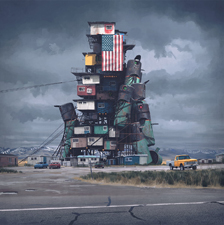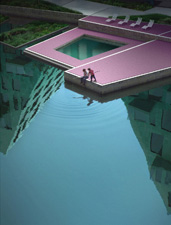[mk_fancy_title size=”16″ margin_bottom=”10″ font_family=”none”] “Osher at Carnegie Mellon University” lecture, delivered on June 25, 2020 [/mk_fancy_title][mk_fancy_title margin_top=”20″ margin_bottom=”0″ font_family=”none”] Thanks to Professor Charles Rosenblum, who presented the first half of this two class endeavor, and to Bea and all the folks at our Fisher ARCHitecture studio, without whom this talk would not have been possible.
Preface
 Architects create drawings and other representations of their projects up front in order to demonstrate project concepts and principals. And at their best these creations communicate project ideas in unique and unexpected ways. In turn those drawings affect the architect’s design process, allowing it to bend and swerve in response to facts and whimsy.
Architects create drawings and other representations of their projects up front in order to demonstrate project concepts and principals. And at their best these creations communicate project ideas in unique and unexpected ways. In turn those drawings affect the architect’s design process, allowing it to bend and swerve in response to facts and whimsy.
In our last talk, Charles lay the groundwork for today’s lecture by outlining the development of architects’ drawings since the Renaissance. Now you have an idea how architectural drawings have been created throughout history and their changing meaning as creative instruments of service.
Today we’re going to talk about the future. How will architects’ drawings be created in the coming decades and how SHOULD they be created? Over the past couple of weeks, I’ve undertaken a kind of detective hunt to discover the answer.
Because I am a practicing architect, the concerns and thoughts I will express this afternoon will be largely practical. Bea and I are interested in learning how our architecture practice should best change in response to the conditions of our times. While resisting the urge to knee-jerk our practice in response to each days headlines, it is important that our process be contextual. That is to say, our projects should respond to the sum total of their surrounding conditions, be those conditions political, philosophical, technological, or poetic.

My interest in developing this talk was to investigate ways of using the amazing tools we architects possess, both analogue and digital, in new ways. I agree with Kendra Smith, who has written that “In this age of extensive computer use and the proliferation of visual stimulus, it is essential that architects question and interpret the media they utilize.”
What do folks who know have to say about this issue? How are other architects facing this challenge? This is what I wanted to learn. So I called an expert, thoughtful Pittsburgh architectural historian, Charles Rosenblum, who it turns out, is interested in the same subject. Charles is a careful man. So when I asked him the question he turned it back to me: Well what are your thoughts on the subject, he asked? I may have tried to make something up; but in the end it was clear I had no ready answers.
Why Now?
 The world is going to hell: The Anthropocene is upon us, bringing with it extreme heat and rabid bugs. The world is turmoil. Why is it important how architects draw their work? Should we even care about such small matters? The astounding thing is this: Thoughtful architects actually BELIEVE that they can change the world. I believe that. We have the temerity to suggest that because we are the folks who design the world, what we draw matters.
The world is going to hell: The Anthropocene is upon us, bringing with it extreme heat and rabid bugs. The world is turmoil. Why is it important how architects draw their work? Should we even care about such small matters? The astounding thing is this: Thoughtful architects actually BELIEVE that they can change the world. I believe that. We have the temerity to suggest that because we are the folks who design the world, what we draw matters.
For sure, most architecture is pretty bad. Banality and repetition rule. And ninety percent of the built environment isn’t even designed by architects. It’s always been that way.
Of course, our profession as a whole doesn’t exactly encourage divergent thinking. Potential clients shop for architects on the web like they are browsing at Target. They find images they like and call me. When they “purchase” my services, they believe they are purchasing a future building that resembles buildings I’ve designed before. So I’m constantly pressured not to diverge from what has worked in the past.
Also, my in-house design process fails to reward original thinking. I know well how to draw parts of buildings that resemble parts I’ve designed before. A longer process means less money. So it’s easy to fall into a rut and cut corners.
Therefore, it’s especially concerning that the methods of representation that architects like myself employ don’t fight these inclinations. My tools are like signposts that only point towards well-travelled routes. It’s the opposite of Robert Frost’s point of view in “The Road Not taken” which has served as inspiration to creative folk since he wrote it in 1915, more than a century ago.
The poem however, is more complex than it appears. A sort of doubling occurs. The poem advocates that we take the less travelled road but questions the nature of choice and, as one writer put it, “the choice itself” And so it is with our tools.
Even as we use them and direct them to produce architecture, they are in turn forming us in ways we cannot know or comprehend at the time.
The Future
Click here to download an illustrated PDF of the rest of this talk.[/mk_fancy_title]
